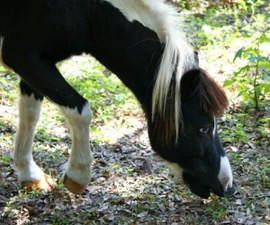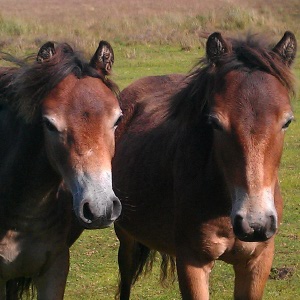How To Help Your Equine With Laminitis Naturally

Learn Why You Should Know About Laminitis
Laminitis is a painful condition of the feet which can affect any horse, pony or donkey. Even some other animals such as cattle can get it. The front feet are more usually affected than the hinds, but all four feet can be affected. (NB: In North America especially, laminitis is known "founder").
The causes of laminitis aren't fully understood by veterinary science. Although research is on-going. A common trigger for laminitis is the eating of lush grass. Overweight or obese ponies being particularly at risk. There's many other triggers to laminitis too. Frosty grass eaten on a sunny day being a typical cause. Even some medicines (taken for other reasons) can have side effects triggering laminitis. If you're concerned, speak to your Veterinary Surgeon as soon as possible.
Symptoms of laminitis vary from mild stiffness, sitting down more frequently than usual through to being unable to walk, or having a very "pottery" gait. A pony with laminitis will sometimes stand in such a way as try and relieve pain on its toes - and be "rocking" backwards. It's important to remember that each animal is different and one may display varying symptoms to another.
How can complementary therapies help your horse, pony or donkey with laminitis?
If you suspect your horse, pony or donkey has laminitis, then as soon as possible, get your vet and farrier to see them. If you quickly get professional (and expert) help, it could prevent your animal's health deteriorating. With laminitis, quick action is important to avoid possible fatal consequences.
Once an equine has had laminitis, he or she is more prone to experience further laminitic attacks. So taking preventative action is important. Your Vet will have conventional medicines to help. And your farrier can also assist through corrective trimming of the feet. Your farrier may use special shoes (e.g. a heart-bar shoe) where appropriate. General stable management and care is important in looking after the laminitic equine. It's often useful to consider using different stable bedding. For example shavings can offer support to the feet, so is better than straw bedding. A targeted exercise programme and careful grass turnout are essential.
There's several complementary therapies available which may also be of benefit. These include the following therapies:
• Acupuncture
Veterinary Acupuncture has been found to be useful in helping equines suffering from laminitis*. There are several Veterinary Surgeons who have completed specialist training to help animals through the use of acupuncture, and are members of the Association of British Veterinary Acupuncture. [*See this veterinary research into the use of acupuncture published in the Canadian Veterinary Journal (2017) https://www.ncbi.nlm.nih.gov/pmc/articles/PMC5508962/]
• Aromatherapy
Essential oils can be used to help animals for a variety of ailments. Professionally trained animal aromatics practitioners have been able to assist equines with laminitis, including helping managing their condition to prevent further deterioration.
• Bach Flower Remedies
A Bach Flower Remedy may help ease the symptoms of laminitis. Choosing the best remedy to suit your animal is of course essential and so consulting with professionally trained practitioner is recommended.
• Equine Sports Massage
Massage can help promote circulation and eliminate toxins, and this can play a vital role in helping an equine with laminitis. As with all complementary therapies, do choose a therapist who is professionally trained.
• Equine Touch
This holistic technique has also been found to assist some equines with laminitis, and so may also be worth trying.
• Feed Supplements
There's a wide range of feed supplements developed (and balanced) specifically for equines who're prone to developing laminitis. Some of the common ingredients found within these supplements may include:
◦ Antioxidants
◦ Arginine
◦ Biotin
◦ Chromium
◦ Spirulina platensis
◦ Omega-3 fatty acids
◦ Zinc
As there are so many available, I'm not listing them here. However, to help you choose between them I suggest you ask your Veterinary Surgeon for advice first. S/he maybe to advise on which would be the most suitable for your animal.
Whilst recommendation of a product's abilities is a useful way to choose a supplement, it's important to note that whilst one feed supplement may work for one animal, it may not work for the next. Each animal is different. It can also take varying amounts of time for your animal (& you!) to notice a difference. Some animals may respond to a feed supplement within 1 week - other animals may take up to 2 months to show any improvement.
You can find more information in this Natural Pet Health blog post
• Herbs for Animal Health
There are several herbs that are believed to help with animals suffering from laminitis, including:
◦ Aloe Vera
◦ Burdock
◦ Chamomile
◦ Comfrey
◦ Dandelion
◦ Nettle
• Hydrotherapy
Hydrotherapy can assist with increasing the circulation within the foot. Therapy could be in the form of a cold water Equine spa, and/or "hot-tubbing" as the warmth can be helpful too. Your Vet will be able to advise on how best to use hydrotherapy to help your animal.
• Homeopathy
Aconite is thought to be useful particularly on the first signs of symptoms of laminitis. Nux Vom can assist especially where the laminitis is resulting from congestion of the circulatory or digestive systems. Thuja may assist with chronic laminitis, including where the hooves may've started to curl upwards. As with any treatment, choosing the correct remedy is important and so seeking the advice of a veterinary surgeon who's qualified in homeopathy is advised. (More info at the British Association of Homeopathic Veterinary Surgeons.)
• Shiatsu
This therapy has been used by numerous equines to help them find relief from the symptoms and help prevent episodes of laminitis.
Conclusion
The holistic approaches listed are above are some of the most common ones used to help horses, ponies and donkeys suffering from laminitis. However, other therapies can sometimes also help. You may find that your equine will benefit from more than one being used - for example, combining a feed supplement with Shiatsu or Massage therapy, etc.
Do remember that any complementary therapy (including feed supplements) can also vary in how quick they are to take effect, and so may need to be used on a regular basis for some time.
As with all complementary therapies do seek the advice of your Vet first before using any of those listed above for helping your laminitic equine. A therapist will always need your Vet's permission before treating your animal, and regular liaison between the two professionals can often bring greater results to your animal's health anyway.
Like help on finding a holistic therapist for your animal? Email us at info@taranet.co.uk - we're happy to help!

Get more information on how to help care for your animal holistically by having a look through our holistic care for animals advice pages:
- Helping Pets Cope with Loud Noises
- Helping Horses, Ponies and Donkeys with Mud Fever
- Older Animals - Ways to Help Holistically
- Osteoarthritis - Help Your Animal Holistically
- Sarcoids and Horses
- Summer Healthcare for Animals
- Sweet Itch and Horses, Ponies and Donkeys
- Tendon Injuries and Horses
